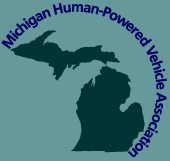The
rally will be held at the Waterford Hills sports car racing track
on the Oakland County Sportsmen's Club grounds in Clarkston,
near Pontiac - the location since 1986. The oldest
such event in
North America is open to riders of all human powered vehicles —
recumbents, streamliners, regular bicycles, tandems and handcycles.
There
are classes for streamlined, unstreamlined cycles, tandems,
women, youth and tricycles. The rally is conducted using Human
Powered Race America rules (www.recumbents.com, then
under "recumbent racing," click on "Human Powered Race
America," then on "racing rules." Note: HPRA
rules require all vehicles to have a mirror or mirrors enabling
rear vision to both sides.
The
track is 1.4 miles around, with nine turns and one hill. Sunday races
use a shorter course without the hill.
Prize
money will be awarded to top finishers in each class. Even if
you don't want to compete, come and see some unusual and some very
fast bicycles and tricycles.
Schedule
of events (subject
to change):
SATURDAY,
June 24
Registration
and tech inspection starts 8 am
1-hour
time trial (faired classes) - 9:30 am
1-hour
time trial (unfaired classes) - 11 am
Lunch
and 1/4 mile hot laps (new event: ride as many laps as you want;
your fastest lap counts), noon - 1:30 pm
Hill
climb/coast down - 1:30-2:30 pm
Tricycle
relay race, rally races (fun events, no points awarded) - 3 pm
Urban
transportation contest - in afternoon.
6
p.m. (approximate) – eat at local restaurants.
SUNDAY
200-foot
sprints, flying start - 8:30-9:30 am
Tricycle
race - 9:30 am
Road
race (faster bikes, 50 laps, 12 miles) –10 am
Road
race (fast bikes 50 laps, 12 miles) –11 am
Awards
ceremony follows the last race, expected before 1 p.m.
Entry
fees: $20 for one day, $35 for two days. For
multi-rider
college or high school or other teams, $20/$35 for first
vehicle/rider; $10 for each additional vehicle/rider. Spectators
free.
Register
online at http://www.hpra.bostonandpop.com/
and save time when you arrive.
For
additional information, contact:
teddwheeler@hotmail.com
Location:
Oakland County Sportsmen's Club: 4770 Waterford Road, Clarkston MI
48346. For a map of the track, visit
http://www.waterfordhills.com/downloads/facilitymap.pdf orhttp://www.mapmyride.com/routes/fullscreen/179549320/
TO
GET TO THE RALLY: From I-75, get
off at exit 91. Take M-15 south to Dixie Hwy. (US-24). Turn left,
continuing south about 1 mile and turn left onto Waterford Road,
then proceed to track.If coming from the west, take U.S. 23
north (or south) to M-59 (Highland Road). Go east on M-59 to
Airport Road, then left (north) to US-24. Turn left, then
immediately right onto Waterford Road. Go about a half-mile to track.
PLACES
TO STAY:
CAMPING
Free
camping available overnight Friday and Saturday at the
Waterford Hills Sportsman Club, site of the HPV rally, starting
at 6 p.m. Friday. Restrooms, showers available and possibly
electrical hookups.
STATE
CAMPGROUNDS (www.michigan.gov/dnr,
then click on "camping andrecreation," then "make a
reservation.
Highland
Recreation Area, 5200 E. Highland Road (M-59), White Lake,
248-889-3750. Two miles east of Highland.
Holly
Recreation Area, 8100 Grand Road, Holly, 248-634-8811. Five
miles east of Holly.
Ortonville
Recreation Area, 5779 Hadley Road, Ortonville, 810-797-4439. Four
miles northeast of Ortonville.
Pontiac
Lake Recreation Area, 7800 Gale Road, Waterford, 248-666-1020.
Closest to Waterford Hills track, about 4 miles west.
OAKLAND
COUNTY: Groveland Oaks County Park, 14555 Dixie Hwy., Holly,
northeast of Holly, 248-634-9811.
PRIVATE
CAMPGROUNDS (www.michcampgrounds.com): Detroit
Sportsmen's Congress Horseshoe Lake Campground, 1050 E. Oakwood Road,
Oxford, 248-628-3859, e-mail dscoffice@gmail.com, www.d-s-c.org
MOTELS
(with approximate distances/direction from Waterford Hills track)
Clarkston
- Clarkston Motor Inn, 6853 Dixie Hwy. (US-10), 248-625-1522,
12 rooms, 2 miles northeast.
Clarkston
- Olde Mill Inn of Clarkston, 5835 Dixie Hwy., 248-623-0300. Across
Dixie Highway from Waterford Road leading to track. This is
the closest motel to the track.
Hartland
- Best Western of Hartland, 10087 M-59 at US-23, 810-632-7177,
61 rooms. About 18 miles west.
Waterford
– Quality Inn and Suites, 7076 Highland Road (M-59), 248-666-8555,
111 rooms. About 3 miles southwest.
Waterford
– Waterford Motel, 2201 Dixie Hwy. at Telegraph Road, 248-338-4061,
50 rooms. About 6 miles southeast.
Waterford
– Holiday Inn Express, 4350 Pontiac Lake Road, 248-674-3434, 83
rooms. About 7 miles southwest.
Whitmore
Lake - Best Western of Whitmore Lake, 9897 Main St. (off US-23, exit
53), 734-449-2058, 61 rooms. About 33 miles southwest.
Note:
The Michigan Human Powered Vehicle Association was formed in July
1984 and officially came to an end Sept. 30, 2016, due to a lack of
active members willing to continue to run the organization. However,
the Michigan HPV Rally continues this year and hopefully in future
years. This blog, website (www.mhpva.org) and Facebook page
(www.facebook.com/mhpva) continue.


















